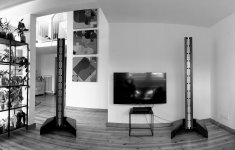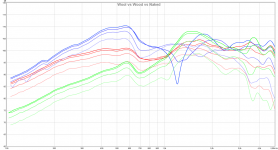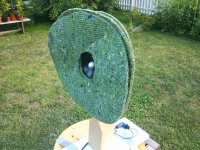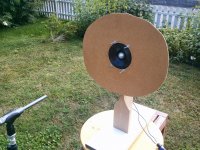thanks for the effort ! they look rahter consistent. i do think your mic or preamp has trouble with the volume thoughat least i hope so, since a consistent 1.5 or more % 2e order distortion over the complete bandwidth is not ok
if you ask me

That is a possibility, especially since I have already ruined one of the inputs on the preamp so it is possible the other one works but performs poorly. I guess in future measurements I'll probably use my USB mic to avoid any such issues.
And when I think about it I've done measurements before in post New planar drivers at Parts Express with driver #1 and in that measurement I got ~ 0.5% 2nd distortion @ 1W.
Having trouble making sense of the curves. Great stuff but can you explain what we are looking at.
I'm a pretty strong advocate of dipoles (or, I guess, multipoles). It would be meaning to me if the panels were mounted on large flat baffles so that I could see what the front radiation was like and then what the back is like. Otherwise, the front and back get mixed together. Granted, that's just like in real life, but more useful to my understanding to see the front and back independently.
B.
I'm a pretty strong advocate of dipoles (or, I guess, multipoles). It would be meaning to me if the panels were mounted on large flat baffles so that I could see what the front radiation was like and then what the back is like. Otherwise, the front and back get mixed together. Granted, that's just like in real life, but more useful to my understanding to see the front and back independently.
B.
Having trouble making sense of the curves. Great stuff but can you explain what we are looking at.
I'm a pretty strong advocate of dipoles (or, I guess, multipoles). It would be meaning to me if the panels were mounted on large flat baffles so that I could see what the front radiation was like and then what the back is like. Otherwise, the front and back get mixed together. Granted, that's just like in real life, but more useful to my understanding to see the front and back independently.
B.
Sorry for the late answer but better late than never:
The first one Frequency Consistency. As shown in the third image of the measuring setup I've placed a measurement microphone fairly close and then placed the planar in a vice in while pushing it against the rivets. This is such that I can swap the drivers and still get a pretty consistent measurement.
And consistency is the key. While I have measured the frequency response of the driver I don't really care about the actual response. If I did I would measure from a greater distance which would yield a more flat curve. What I care about is how different is every driver to each other driver.
All drivers are different, the best drivers are not good just because of fancy motors and such. They are good because the drivers have excellent consistency. With such you can take any driver and swap it with any other and you wouldn't have to change the crossover, it would perform pretty much the same.
For Bohlener Graebener original drivers that isn't true, and especially not true as of late. In fact the driver to driver consistency got so bad that at least some suppliers stopped stocking them.
That is what made me suspicious of the GRS drivers since they are suspiciously cheap clones of the BG planars. I expected consistency to be pretty bad, although for the price I was willing to accept a few garbage drivers and some better and some worse.
In the end I didn't really have any bad drivers. With the exception of below 700 hz the driver to driver variation is really good. At worst around 3 dB and mostly better.
That is great for me since I'm building a shaded array and it would be a pain to have to tailor the shading for each specific driver. As it is now I need 14 drivers and have 17 so I'll just put away the outliers as spare drivers and then average the response of the rest. Then I'll use that average driver as basis to calculate my shading.
Impedance Consistency is masuring the resistance of the driver. It says 8 ohms but it's not really 8 ohms. It is rather 6.5 ohms with a bump around the resonsance frequency. Here too we want all drivers to be as closely clumped as possible for easy use.
crossover
How did you implement the crossing over of frequencies?
Use EQApo and RePhase -> pure clean mathematically correct control over Time and Frequency domain. Many TAPs steep steep filtering > 80db>Okt to prevent "coiling". No MiniDSP etc. unless FIR and no analog input into these: DA/AD/DA conversion will destroy the sound. The worst is "Phase Errors" due to "conventional" crossovers. These will destroy all imaging and add coloration due to uncontrolled summing up of frequencies and time shifts.
Best dedicated class A amplifiers for each driver mid/ treble, maybe the JLH 1969. Bass best class A/B. If you change the electric side it will be a complete different thing! ..my experience!
I sure do! Thx.
How did you implement the crossing over of frequencies?
Use EQApo and RePhase -> pure clean mathematically correct control over Time and Frequency domain. Many TAPs steep steep filtering > 80db>Okt to prevent "coiling". No MiniDSP etc. unless FIR and no analog input into these: DA/AD/DA conversion will destroy the sound. The worst is "Phase Errors" due to "conventional" crossovers. These will destroy all imaging and add coloration due to uncontrolled summing up of frequencies and time shifts.
Best dedicated class A amplifiers for each driver mid/ treble, maybe the JLH 1969. Bass best class A/B. If you change the electric side it will be a complete different thing! ..my experience!
Attachments
I can verify that the same trick works on a normal Neo8, it does extend the high end a bit. I have gotten more smooth results with a less wide baffle though, on the order of 10 cm or less. This 30 cm baffle is a bit extreme but I wanted to specifically test the extreme case in that measurement.
With a smaller baffle that covers ~ 10 cm and that covers the outermost two holes we get the following on a Sounderlink Neo8 which is basically the GRS wide 8" but more expensive, more distortion and less consistency*. (*My guess based on the consistency of the slims, probably similar for the other planar drivers from GRS)
Note that even with those tricks the top end at 10 khz and above is still worse than the slim. Not by a huge amount sure but a bit worse.
There is also the fact that the wide 8" is well, more wideProbably not an issue for most but I'm building a dipole and in this case it is very advantageous to have the slim design. A dipole with a hard baffle will create a null on the other side, as can be seen in the measurements. The bigger the baffle relative to the radiating area the bigger the null. It's not a huge null but it is there from 4-7 khz and no amount of wool I have thrown at it has eliminated it.
The slim driver has a lot less baffle but the same radiating area, so this null is pushed higher in frequency which is a good thing. I believe with some tweaking of the wool baffle (mostly reducing width or curving it to create a mini-waveguide) and with more drivers I can eliminate the null with the slim driver.
What do you mean by "create a null on the other side" and is it in the masurements you attached to this post?
If your talking about the rear side, that should be the same as the front. Or are you talking about edge diffraction off the edge of the baffle? But that is hardly the other side?
What do you mean by "create a null on the other side" and is it in the masurements you attached to this post?
If your talking about the rear side, that should be the same as the front. Or are you talking about edge diffraction off the edge of the baffle? But that is hardly the other side?
With a hard circular baffle that is wide relative to the driver it creates a sharp null in the 0 degree direction to the front and the rear:
Here are [0, 15, 30, 45] measurements of a 6.5" midrange (AE TD6M) on a 50 cm wide circular wool baffle (Red), 50 cm wide circular wood baffle (Blue) and naked with no baffle at all (Green).
With a solid baffle there is a sharp dip at 1200 hz -ish @ 0 degrees. That null with a solid baffle is basically the reason why so many dipole builders go for no baffles or very small baffles. Usually 4-way since then you can't have both the low frequency extension of a small baffle and the high frequency smoothness of no baffle.
The wool baffle smushes this around and just reduces the 0 degree by 1 dB or so in the 700 - 1200 hz range. The tradeoff is that we get almost the same low frequency as with a solid baffle which is huge and in my opinion well worth it considering how minor the impact is in the 700 - 1200 hz range.
Addition: This is the extreme case since the rear of the cone driver stops impacting the front since it is not symmetrical over the whole range. When using planars then you can't just go super wide baffle without any tradeoffs at all, I've gotten the most smooth results with moderate wool baffles of around 2x the width of the driver. New planar drivers at Parts Express has a fairly wide baffle and a bit more impact even with a wool baffle. Since I'm building a line of them with a CBT I expect the line to smooth things out somewhat so I'll probably go a wide baffle anyway. Plus it lets me cross lower =)
Addition #2: In the picture I have 3 sheets of 10mm wool carpet. In my later measurements I have found that a single sheet of 10mm wool carpet yields pretty much identical measurements.
Graphs taken from my earlier experiment thread Dipole wool carpet baffle experiment
The dip in the 700 - 1000 hz region is because of the driver, I suspect the culprit is the extremely large magnet which blocks the rear quite a bit.
Attachments
Last edited:
And crazy overall sensitivity. Active DSP systems could really sing with this driver I think. I'm toying with the idea of 6-8 per side in a line array.
Just curious if you've had a chance to build and test this system? Pictures?
Thanks
Paul
Just curious if you've had a chance to build and test this system? Pictures?
Thanks
Paul
Not likely anytime soon, sorry to say.
Greg
I'm sorry to hear that Greg. Sounds like a complicated reason for not moving forward with the project...
I'm about to place an order for 16 GRS PT5010-8 10" Planar Mid/Tweeters 8 Ohm and 32 GRS PT2522-4 3-1/2" Planar Tweeters 4 Ohm to create a 6½' tall Line Source. I'm considering making a structure like the IRS V with wings to help with the low end response. It'll be all active with a BSS BLU800 handling the crossover duties.
Thoughts/suggestions of things to think about and consider???
Thanks
Paul
I'm about to place an order for 16 GRS PT5010-8 10" Planar Mid/Tweeters 8 Ohm and 32 GRS PT2522-4 3-1/2" Planar Tweeters 4 Ohm to create a 6½' tall Line Source. I'm considering making a structure like the IRS V with wings to help with the low end response. It'll be all active with a BSS BLU800 handling the crossover duties.
Thoughts/suggestions of things to think about and consider???
Thanks
Paul
Just bought the slims. I'll be trying them with an active 8th order at 600hz(Maybe a little lower) in a sealed cabinet and DSP'd to flat through 20khz. That should take care of a lot of the 2nd and 3rd HD that's showing up in the plots. There's a few other things I'd like to try also. Should be interesting.
They'll be competing with what I have on top at the moment..
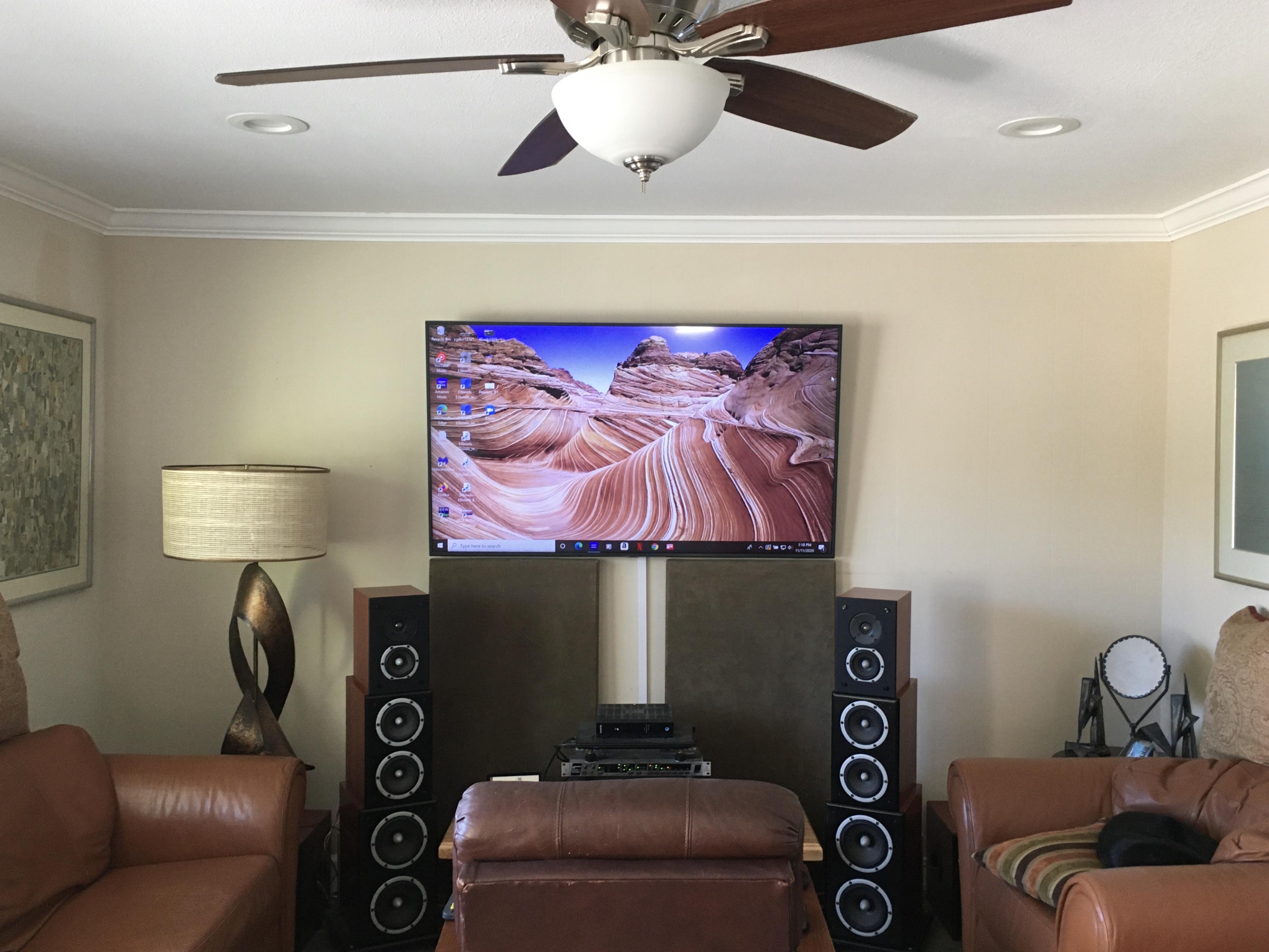
They'll be competing with what I have on top at the moment..
Last edited:
I'm sorry to hear that Greg. Sounds like a complicated reason for not moving forward with the project...
I'm about to place an order for 16 GRS PT5010-8 10" Planar Mid/Tweeters 8 Ohm and 32 GRS PT2522-4 3-1/2" Planar Tweeters 4 Ohm to create a 6½' tall Line Source. I'm considering making a structure like the IRS V with wings to help with the low end response. It'll be all active with a BSS BLU800 handling the crossover duties.
Thoughts/suggestions of things to think about and consider???
Thanks
Paul
That should be very impressive! Hopefully there's good unit to unit consistency with the 10" units, let alone the 3" units. Tensioning diaphragms perfectly from one unit to the next is very difficult and can create large variations between units if not done correctly. I'm really wondering how they can pull these prices off while still maintaining high QC standards
That should be very impressive! Hopefully there's good unit to unit consistency with the 10" units, let alone the 3" units. Tensioning diaphragms perfectly from one unit to the next is very difficult and can create large variations between units if not done correctly. I'm really wondering how they can pull these prices off while still maintaining high QC standards
While I can only attest for the drivers I have, the consistency seems to be pretty good. I bought 17 slim 8" and measured all of them earlier in the thread.
How this transfers to the 10" is another matter but the factory seems to know what it is doing when producing the slim 8"s.
Thanks for providing a link. I skimmed all the pages for measurements, but somehow missed those
They look good, especially considering that you're using a very expanded vertical scale. Everything seems to go south below 600hz though
If I get a lot of variation in my pair of slims, Ill probably be sending them back. Sadly, my pair of BG Neo 10's had variations that were just too hard to live with(I may have damaged one). My BG neo 3's are fine though. If need be, I can take these up to 800hz with an 8th. I could live with that if it means better consistency
They look good, especially considering that you're using a very expanded vertical scale. Everything seems to go south below 600hz though
If I get a lot of variation in my pair of slims, Ill probably be sending them back. Sadly, my pair of BG Neo 10's had variations that were just too hard to live with(I may have damaged one). My BG neo 3's are fine though. If need be, I can take these up to 800hz with an 8th. I could live with that if it means better consistency
Last edited:
I'm really big on soundstage. If there are a lot of variations between single stereo units between 800hz and 5khz, the soundstage has a tendency to swim around between the speakers and that drives me nuts. The nice thing about tall line sources are that all those differences tend to average out and are no longer an issue, in theory anyway
Christie must have sold the rights to reproducing these drivers to GRS. It's about time they did. Apologies if someone already mentioned this.
That would be great because the B&G are dreadfully expensive now. On another note, there seems to be foam/felt difference between the NEO8-PDR and GRS slims. I believe the NEO8 has felt on both sides and GRS only has felt on one side (looking at the pictures). Can anyone confirm this?
Thanks,
Per a post on TechTalk forum...
"The planar speaker patents in David Graebener's name, mostly for American Technologies Corporation (now LRAD Corporation), have all either expired due to nonpayment of fees, or have been abandoned. It makes sense, as they don't fit with LRAD Corporation's business direction. By appearances, this material is now in the public domain as prior art."
"The planar speaker patents in David Graebener's name, mostly for American Technologies Corporation (now LRAD Corporation), have all either expired due to nonpayment of fees, or have been abandoned. It makes sense, as they don't fit with LRAD Corporation's business direction. By appearances, this material is now in the public domain as prior art."
These are actually Igor Levitsky's BG Radia Pantents that were acquired by Christie back in 2013. These drivers were designed around 2005, so there's around four years left on the patent, give or take a few years. Graebener's expired patents were for the famous long planer magnetic drivers
US6810126B2 - Planar magnetic transducer
- Google Patents
US6810126B2 - Planar magnetic transducer
- Google Patents
Last edited:
- Home
- Loudspeakers
- Planars & Exotics
- New planar drivers at Parts Express
